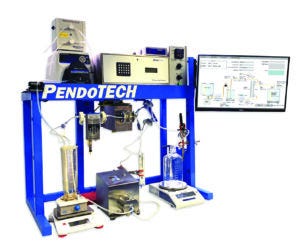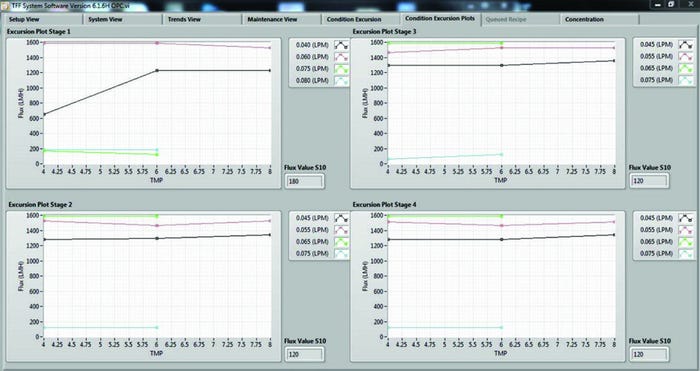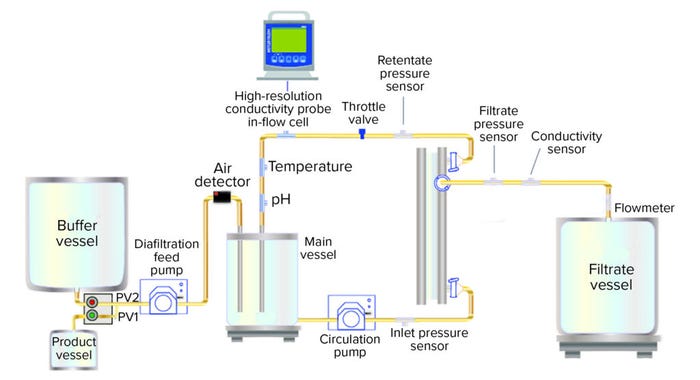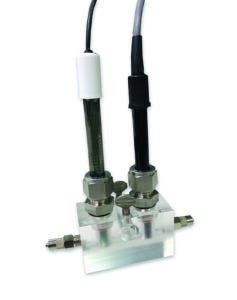- Sponsored Content
- Filtration
- Process Monitoring and Controls
Tangential-Flow Filtration Process Control and Data Acquisition System for Process DevelopmentTangential-Flow Filtration Process Control and Data Acquisition System for Process Development
December 6, 2022
Sponsored by PendoTECH

Photo 1: PendoTECH TFF process control system benchtop configuration.
PendoTECH tangential-flow filtration (TFF) process control systems have been widely adopted in the filtration community. The system’s features enable its implementation in multiple unit operations and biopharmaceutical processing applications, including ultrafiltration–diafiltration (UF–DF) of proteins, viruses, and compounds such as oligonucleotides and antibody–drug conjugates (ADCs). The control system can be used to develop process parameters for UF–DF processes that have different membrane formats (e.g., flat-sheet cassette and hollow fiber).
TFF laboratory setups often are manual or semiautomated processes that use pumps, stainless-steel pressure gauges or transmitters, scales, and manual valves. Data logging requires continuous monitoring, and exporting data requires laborious efforts to transfer to data analysis software. Integrating multiple system components from different suppliers and using manually operated clamps and valves to control transmembrane pressure (TMP) can be problematic. Large holdup volumes caused by nonoptimal flowpath setup can occur, thus limiting final concentration values.
The PendoTECH TFF process control system is versatile and scalable. A standard setup comprises two pumps and two scales in a benchtop configuration (Photo 1) or in a process cart when large volumes must be processed. A feedback control-loop based on a tubing throttle valve adds automated TMP control when needed. The system can measure parameters such as flow rate, conductivity, pH, and temperature. Two configurable inputs can be added to measure UV and concentration. The system also has the flexibility to operate different pumps, including a permeate pump.
The control system includes PendoTECH single-use pressure sensors, which are available with 1/8-inch to one-inch hose-barb connections and in a luer fitting and sanitary flange (triclamp, TC) format to handle all process scales while minimally influencing holdup volume. The system has no process-scale limitations, thereby enabling users to scale up or down easily with minimal outlay and space requirements as a process advances from a benchtop to pilot-scale setup. The system integrates with different types of pumps, scales, and flowmeters. It enables users to build flowpaths that incorporate filters from different manufacturers. It has options for filtrate flow and flux measurements with a flow meter or rate of change in scale weight (without the need for a flow meter). System alarms enable processes to run while unattended.
The PendoTECH TFF process control system provides a high level of automation, in-line process monitoring, and process data collection and trending. The system provides complete batch control with six built-in programmable recipes. System interaction is conducted with a PC-based graphical user interface (GUI), which writes process data in real time to a comma-separated values (CSV) file, thus enabling improved integrity of data exported for analysis by third-party software, or the data can be opened using Microsoft Excel software. The software also includes a built-in server to exchange data with OPC client software such as PI (from OSIsoft) for external storage to a database.
Visualizing Optimal Process Conditions for Scale-up
The system includes an “excursion” feature that enables users to execute 40 filter feed flow and TMP conditions automatically and to graph data to visualize optimal conditions. The automation sequence can handle up to four different concentrations by reducing the retentate vessel volume between four stages (up to 10 steps each). Figure 1 shows the real-time graphs that are generated during an excursion to optimize the flux rate.

Figure 1: Software process excursion illustration to visualize optimal process conditions.
Achieve High Concentration Factors: Fed-batch Mode
The system can operate automatically in fed-batch mode to achieve high concentration factors (>20×) by dynamically adding materials to the retentate vessel at the same rate of permeate through the filter. Figure 2 shows the system process schematic. The automated valves labeled as PV1 and PV2 let the diafiltration feed pump draw liquid from the product vessel or buffer vessel. The noninvasive air detector senses whether there is air or liquid in the tube and detects the end of the product feed in a fed-batch process step. Once all product has been added, concentration occurs within the vessel. When the desired concentration point is reached, the software will control the diafiltration step automatically. That is followed by an automated final concentration step. Such features can be valuable when concentrating highly dilute virus and when trying to achieve high protein concentrations.

Figure 2: PendoTECH TFF process control system process schematic.
Pump Shear Forces and Pressure Capability
A limitation of some TFF systems is that they cannot be used to make dynamic changes that conform to the requirements of a biomolecule being investigated. One such parameter is the shear force that a biomolecule can withstand.
Process fluid is circulated continuously at high frequency, so pumps have an important role in TFF processes. Peristaltic pumps are a favorite choice among users because they are convenient and economical, and they accommodate larger tubing sizes for increased flow rates. But they are not best when there is a need to have a consistent flow rate at high pressures, and such pumps can subject biomolecules to high shear forces as flow rate increases. Most peristaltic pumps have four rotors that engage a tube four times per rotation of the pump head, thus forcing liquid forward at a required flow rate. The high-frequency engagement of a rotor to a tube creates pinch points and pressure gradients as liquid is drawn in and rapidly released. As product is concentrated, the frequency rapidly increases. At moderate pressures, the design of a peristaltic pump makes it unable to physically deliver against a back pressure beyond the prescribed limits of the pump and tubing. So as back pressure increases, flow rate can drop and create an unsafe situation in which tubing ruptures.
For processes that require the generation of high pressures, a diaphragm pump (a positive-displacement pump) might be the best choice because liquid is drawn into the pump chamber and then pushed out. This pump design continues to maintain a consistent flow rate against high back pressure generated during a filtration process. That often is needed when operators try to reach high-concentration factors because a product being circulated continues to reduce in volume while its viscosity increases.
Centrifugal pumps transfer fluids from inlet to outlet points of a pump chamber. The basic mechanism of such a pump relies on an impeller that spins, drawing in fluid and expelling it through an outlet at a desired flow rate. Thus, the impeller must increase its speed to maintain a constant flow rate as back pressure increases. As fluid viscosity increases, the resulting increase in pressure causes the flow rate to decrease, unless the pump-outlet flow rate is measured and feedback is given to the impeller to control flow rate.
For shear-sensitive molecules, diaphragm or centrifugal pumps are recommended. Their designs inherently create less shear, which can influence a biomolecule. The degree of impact must be determined by experimentation.
The PendoTECH TFF process control system enables changes to be made by switching a pump as dictated by biomolecular properties. The main requirement is that the chosen pump must be controlled remotely by the PendoTECH system with a 4-20 mA or 0-10V input.
Conductivity: Desalting Application
The PendoTECH TFF control system has built-in devices for process monitoring. The standard conductivity input that incorporates the in-line PendoTECH single-use conductivity sensor can measure conductivity up to 100 mS/cm with a sensitivity of 0.1 mS/cm.
More sensitive conductivity meters are required for applications such as oligonucleotide synthesis and purification. Oligonucleotides are short DNA or RNA molecules, oligomers used in applications such as genetic testing, research, and forensics. They are chemically synthesized using nucleotides and a synthesizer to generate well-defined sequences of residues. They can be manufactured as single-stranded molecules with a specified sequence and are vital for artificial gene synthesis, polymerase chain reaction (PCR), DNA sequencing, molecular cloning, and as molecular probes.
Typically, oligonucleotides are made by solid-phase chemical synthesis. One step in achieving a high level of purity and low levels of salt is to purify using solid support such as reversed-phase chromatography (RPC). As the scale of synthesizing the targeted oligomer increases, so do the costs associated with using RPC solid supports for removing undesired fragment lengths. Desalting also can add to overall manufacturing costs.

Photo 2: PendoTECH small-scale process flowcell for 12-mm probes for critical process measurements.
One option being investigated is the application of filters used in TFF to desalt oligonucleotides. That requires a conductivity meter that has a sufficiently high level of sensitivity to detect salts in the μS/cm range. To assist in measuring low conductivity in that range, a sensor with a sensitivity range that is broader than that of a built-in sensor is required. A high-sensitivity monitor can be connected to one of the available generic inputs. PendoTECH offers specially designed acrylic low-holdup flowcells so that users can implement an 12-mm-diameter probe for an in-line measurement (Photo 2).
The Mettler Toledo M300 transmitter can read high-sensitivity probes and be integrated with one of the generic configurable inputs to the PendoTECH TFF control system (Figure 2). With the appropriate probe selected, the system can be used to measure process liquid in μS/cm. That can increase desalting efficiency by monitoring inline to a high sensitivity, helping to reduce overall process costs.
Safe Handling of ADCs
ADCs are a class of biopharmaceuticals designed for targeted therapies for tumor cells. The TFF operations for ADCs typically are done in a biological safety cabinet (hood) to reduce human exposure to toxic components linked to the antibody. From a safety perspective, the modularity of the PendoTECH control system configuration enables users to set up process components in an enclosure and/or laminar-flow hood, keeping the computer outside the area for remote control to minimize process interventions. The automated recipes in the GUI let users safely operate a process with minimal exposure. The “manual recipe” mode enables broad control of the pumps and valves in the setup by means of the computer.
The system also enables users to open a second GUI software package on the computer that is connected to the same TFF process control system. The PendoTECH VF-DF software can control and automate a normal-flow filtration process and offers the ability to optimize and scaleup a filtration operation.
Mahesh Khot, PhD, is control system sales manager at PendoTECH; [email protected].
You May Also Like





